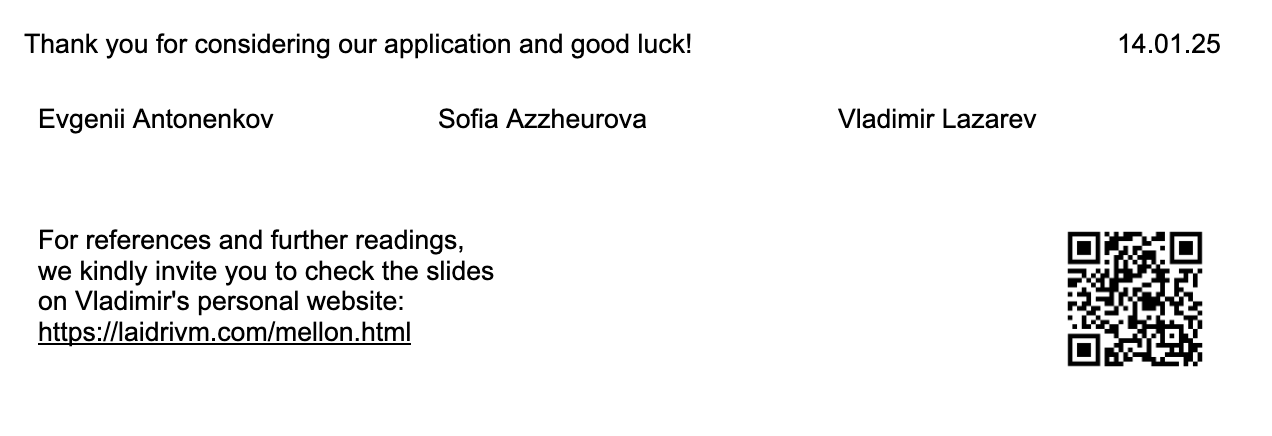
Guide to Portugal Startup Visa: Obtaining an IAPMEI Confirmation Letter in 2025
In February 2025, I applied with my project to IAPMEI — a Portuguese government agency responsible for filtering prospective projects. They issue a confirmation letter — a document that enables the founding team to apply for a Portugal Startup Visa.
In April 2025, I created a prototype to demonstrate project updates. In May 2025, I was asked to provide additional documents. The final result is still unknown, but the fact that the application wasn’t immediately rejected is considered a good sign.

The process of obtaining temporary Portuguese residence through a startup is long, complex, and surrounded by contradictory information. It took me two months — one of them full-time — just to prepare the documents for the initial application and submit them via the IAPMEI platform. Yet, it remains easier and more affordable comparing to Spain or Finland startup programmes.
This guide covers the process starting from the moment you’ve already decided to obtain a visa and residence permit via a startup — up to receiving confirmation from IAPMEI, which is the key artifact in this journey. It omits:
- Possible motivation to apply.
- The program’s benefits and limitations.
- The consulate application.
- The actual relocation and exchange of the visa for a residence permit.
If I cover those topics later, I’ll cross-link the related articles. For now, here’s what remains within the scope of this guide:
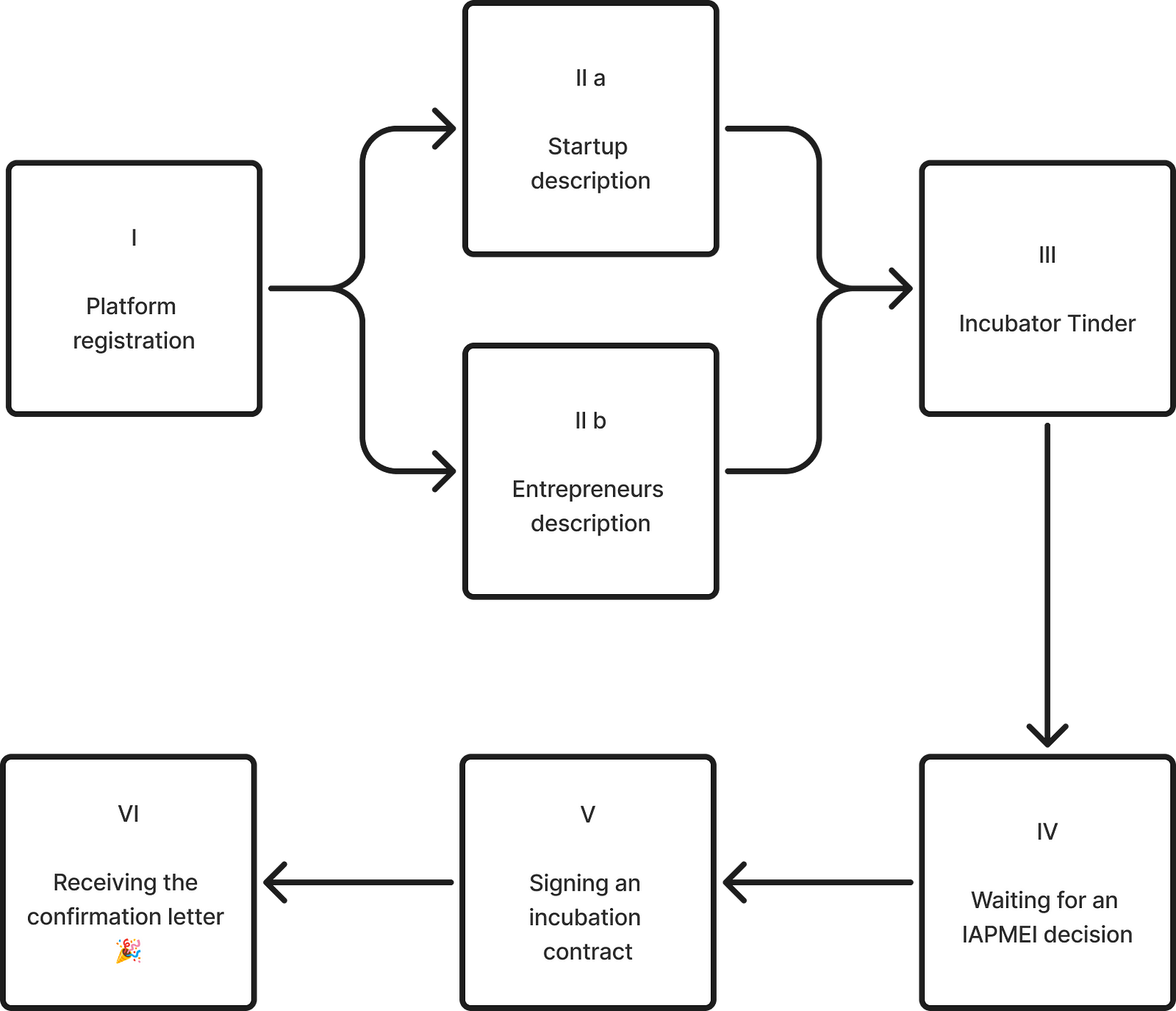
This guide is based on my experience and includes examples from my own application. I focus only on the aspects essential for the application. That means some business-related decisions might not reflect how you would build and develop a real startup — and that’s okay. No one will force you to execute everything exactly as described. But aligning with the formal structure will increase your chances of approval.
This guide is quite detailed. I recommend reading it once in its entirety — even briefly — to understand the scope of work and key checkpoints. Later steps might influence decisions made earlier. After that, go step by step, returning to the section that’s most relevant to your current progress.
The process is straightforward. You just need to:
- Register on the platform.
- Describe your project and founding team.
- Get approval from a certified incubator.
- Wait for IAPMEI’s decision.
- Sign a contract with the incubator.
- Receive the IAPMEI confirmation letter after the incubator uploads the contract.
However, there are major pitfalls.
There are two ways to apply: with an existing project or with a new project idea. I applied with a new project, and I highly recommend doing the same — even if you already have a startup with funding, an MVP, or traction. Applying with an existing project is more complicated and more likely to be rejected. I know founders who relocated their businesses to Portugal using visas for “new” projects.
You must come up with a completely new project, unconnected to any of your existing or previous ventures. Otherwise, you may be rejected for presenting an existing project as a new one. Even a domain registration or a LinkedIn entry might be enough to trigger rejection.
This is the first resource-draining step: describing your project according to both formal requirements and informal expectations. The second is identifying and obtaining all the required supporting documents — especially difficult if, like me, you’re living outside your country of citizenship.
Finally, you’ll need to carefully review everything before submitting. In late 2024, many community reports noted that IAPMEI had begun rejecting applications on formalities — with no way to appeal. To avoid this, stick to the guidelines.
There are some unexpected upsides. Most importantly, you can prepare all the documents in English — which helps if certified Portuguese translators are unavailable where you live.
I applied as the representative of a founding team of three members:
- Me — a software engineer
- Sofia — a designer
- Evgenii — a marketer
Each of us plans to relocate with our families.
This setup is typical. Only one representative needs to register on the platform, create the project, and submit all the documents. You can include 1 to 5 founders per application, but according to community experience, 2 to 4 is the sweet spot. Fewer or more significantly reduce your chances.
Founders can list their spouses as co-founders — or not. This can help optimise your team size. If spouses are included as co-founders, they can each apply using the confirmation letter or as dependents of the main applicant. Otherwise, they can apply only as dependents.
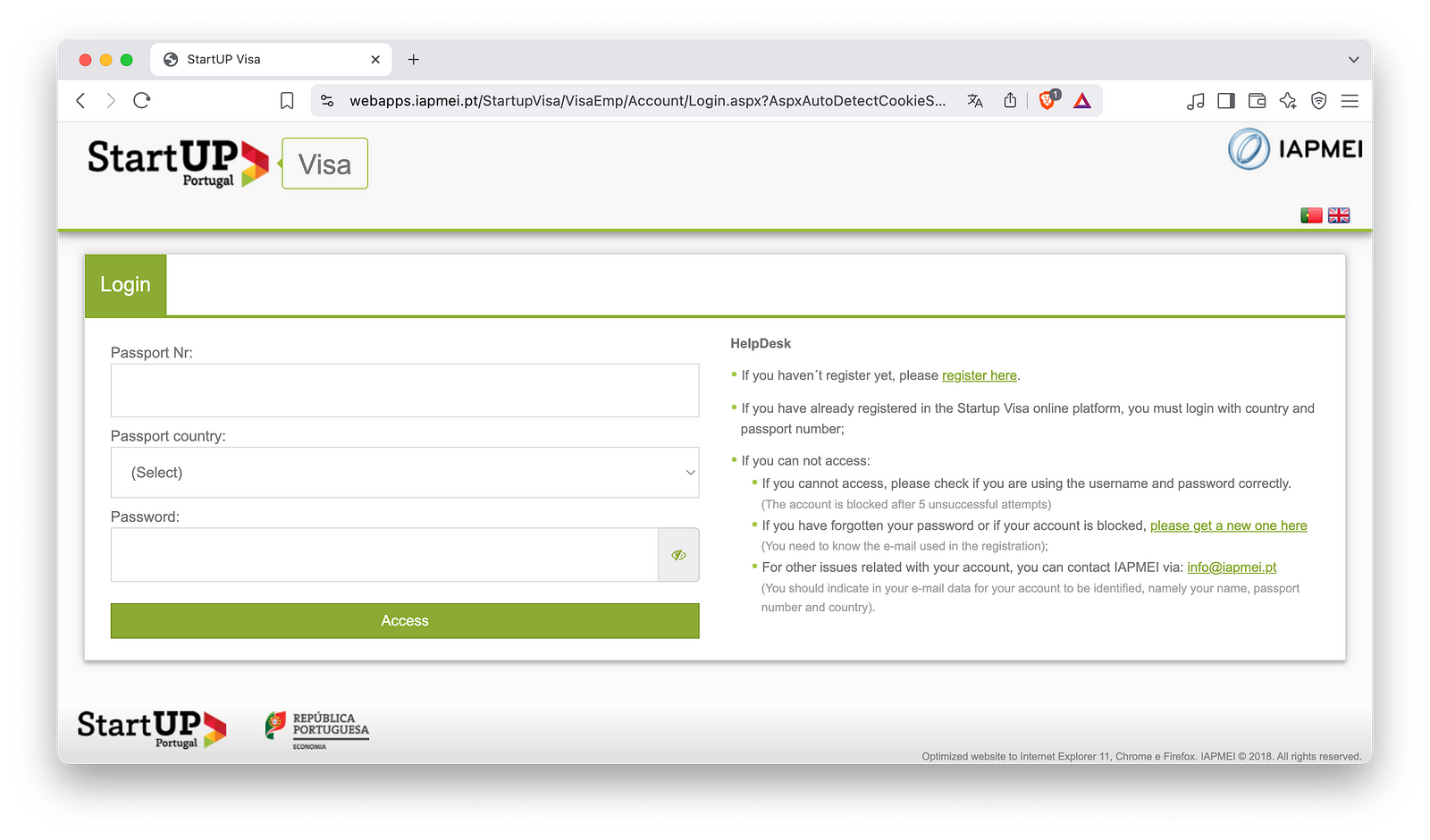
The journey begins at IAPMEI’s platform, which is localized in English — a welcome convenience. Registration is simple: you enter your (foreign) passport number, issuing country, full name, phone number, and create a password. Then confirm your email — and you’re in. Use only a personal email address — don’t use a work or project-related one.
After logging in, you’ll find references to the documents governing the program:
You’ll also find the official site, which links to helpful docs:
It also mentions the Social Support Index (IAS) for 2025: €522.50/month × 12 = €6,270.00 — the minimum amount each founder is expected to show in their bank statement.
The platform lists the contact email startup.visa@iapmei.pt, which you can later use to update authorities about your project or ask about your application. You can also clarify any unclear requirements — but most formal details are already covered in the regulations, guide, and FAQ. Informal ones are best learned from the community — I’ll list sources at the end of the article.
Back on the IAPMEI portal, click “Access” — the orange button in the top right corner:
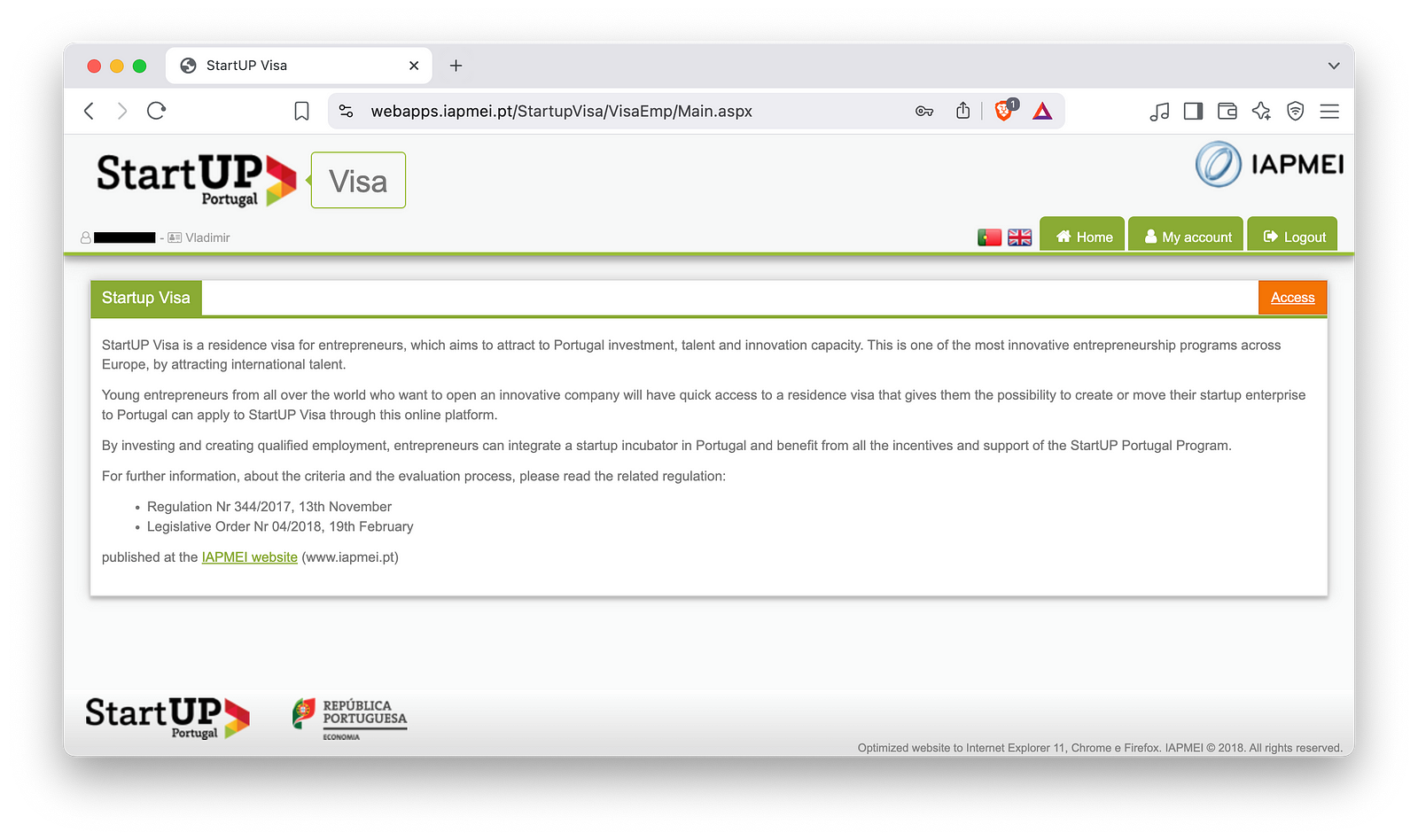
There, you can create a new application — which we’ll be working with from here on.
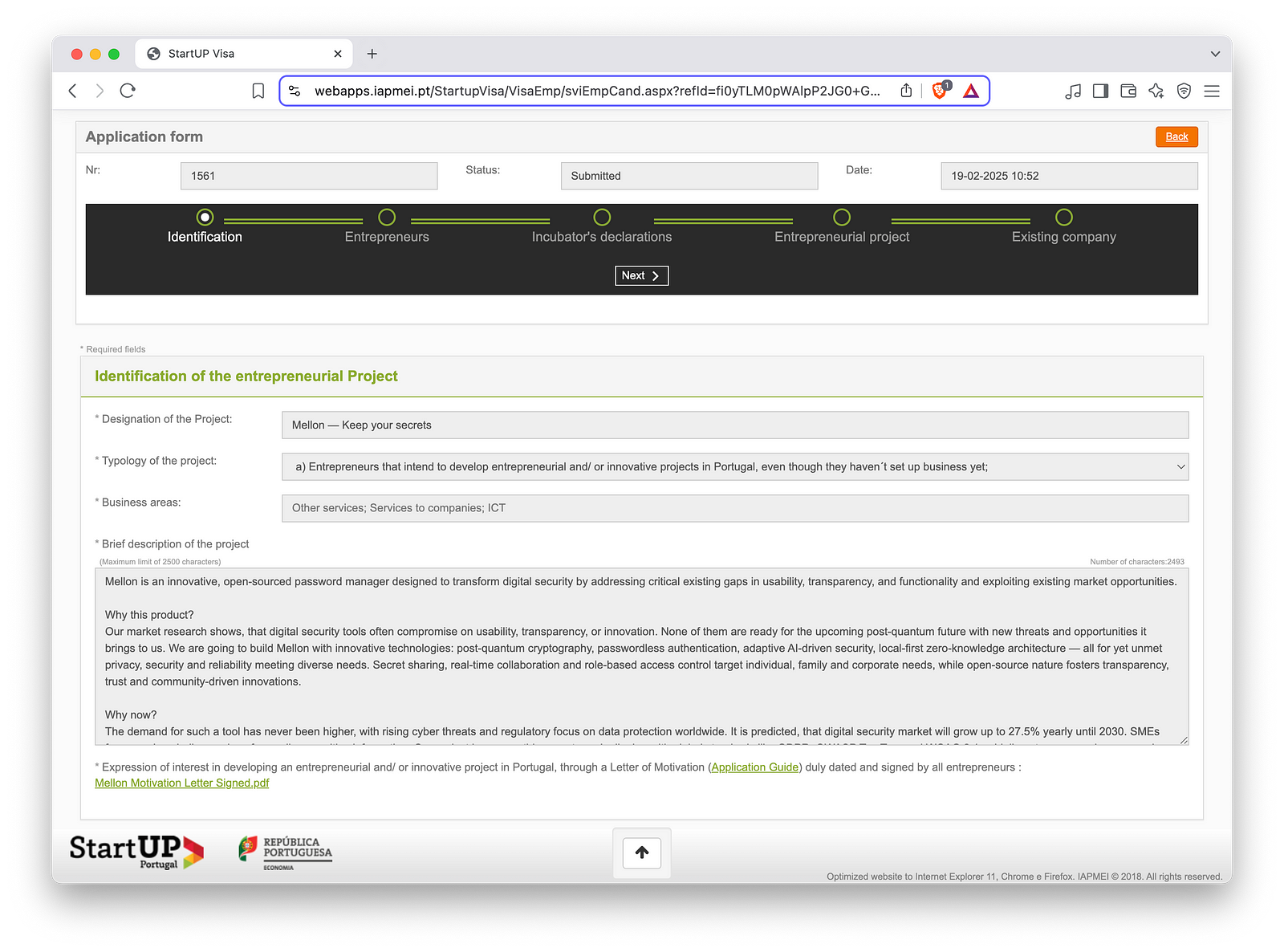
At this stage, the process mainly consists of filling in web forms. Text areas have a 2,500-character limit, so you’ll need to trim your content to fit. Extra characters are automatically cut off.
I highly recommend creating a separate document to collect all the form content and supporting information. You can use Google Docs, Notion, or another tool of your choice. I suggest including the following:
- ToDo
- External Links
- Business Plan
- Marketing Research
- Designation of the Project
- Brief Description of the Project
- Letter of Motivation
- The Innovative Nature
- Justification of the Internationalisation
- Identification of the technology or knowledge
- Job Creation Potential
- Estimated Values
- Submission Checklist
- Overview Slides
- Incubation Slides
- Readlist
This document is helpful because:
- The platform may lose your data if you forget to save or are logged out. It’s safer to draft everything offline and copy-paste.
- Having the full application on one page helps identify inconsistencies and track your progress. You’ll also reuse the content when creating follow-up documents or slide decks.
- You can use it for side notes, links, and reference material.
- It helps you iterate — make a first pass, then improve until you’re satisfied (or exhausted enough to hit submit).
One more tip: be as specific as possible when describing your project. Use numbers to support your claims or provide calculated assumptions. List key features, technologies, or skills relevant to implementation. This shows confidence and preparation.
You’re not expected to validate hypotheses at this point. Instead, focus on the problem you’re solving, your solution and its scope, potential features, and your unique selling proposition.
The main thing — competitors, not your fantasies. If something doesn’t exist in Europe, take the American market. Show innovation relative to potential rivals, compare prices too. Imagine you’re explaining everything for 50-year-old people who work in IT but don’t understand technical details.
Don’t forget to mention that you comply with GDPR and other things that are important for Europeans.

This is your project’s brand name — how IAPMEI will refer to you. Choose something short and recognizable. I used my product name and slogan: Mellon — Keep your secrets. Inspired by The Lord of the Rings and a related meme, I thought it was fitting for a password manager — the product I applied with.
This is an executive summary of your project. Try to answer the 3 Whys: Why, When, and Who — without getting into many details. Also, please highlight that you meet the requirements of the main application:
- The innovative nature of the product.
- Internationalisation business potential.
- Technologies or knowledge that support the innovation.
- Job creation potential.
Here’s the text I submitted:
Mellon is an innovative, open-sourced password manager designed to transform digital security by addressing critical existing gaps in usability, transparency, and functionality, and exploiting existing market opportunities.
Why this product?
Our market research shows that digital security tools often compromise on usability, transparency, or innovation. None of them are ready for the upcoming post-quantum future with the new threats and opportunities it brings. We are going to build Mellon with innovative technologies: post-quantum cryptography, passwordless authentication, adaptive AI-driven security, local-first zero-knowledge architecture — all for yet unmet privacy, security, and reliability needs. Secret sharing, real-time collaboration, and role-based access control target individual, family, and corporate needs, while the open-source nature fosters transparency, trust, and community-driven innovations.
Why now?
The demand for such a tool has never been higher, with rising cyber threats and a regulatory focus on data protection worldwide. It is predicted that the digital security market will grow up to 27.5% yearly until 2030. SMEs face growing challenges in safeguarding sensitive information. Our project leverages this urgent need, aligning with global standards like GDPR, OWASP Top Ten, and WCAG 2.1 guidelines to ensure relevance and market readiness in Portugal and beyond — to Germany, the Netherlands, France, Switzerland, the Nordics, and other countries. More than 75% of individuals using the internet resort to unreliable methods, leaving a large niche to be taken.
Why with these founders?
The founding team combines deep technical expertise, creative vision, and strategic market insight. Vladimir has successfully managed engineering teams, scaled complex systems, and implemented frameworks that drive operational excellence. Sofia specialises in creating intuitive, accessible, and inclusive interfaces that enhance usability across diverse demographics. Evgenii brings market trend identification, user acquisition, and compelling narratives that resonate with target audiences. Our passion for transparency and user empowerment ensures a product built for long-term trust and user admiration. We aim to build a scalable business that benefits individuals, SMEs, and a wider community, and positively impacts the Portuguese economy by creating highly qualified job positions.
More on market research and product details:
Here and below I try to attach to each piece of information submitted a link to the full application text. I just edited all the content I had about the project and published it as a long-read on my personal site. A Tilda page or a Medium publication will also do. Such a link pursues two goals:
- Provide a whole picture of your project
- Provide sources for references you might use throughout your application. I.e., I write “… market will grow up to 27.5% yearly until 2030.” Then I add a wiki-like reference mark [1] and provide the source on this external page — not to take up the limited space of the form fields. I keep this numeration consistent through all the fields.
Instead of a long-read, you might create and publish slides that fit the same goals — that’s also fine.
That should be a single A4 page, dated, and signed by all the founders under their full names. Use the pronoun “we” everywhere in its text.
On the one hand, it should also cover the startup idea in general. On the other, there are a few more things you should highlight here:
- How founders’ roles organically align with each other.
- Market research arguing in favour of Portugal. Something like: “According to the research of such and such university from 2020, the number of such things has increased by 2 times compared to 2015, which confirms…”. You might use Statista and StartupPortugal or find other sources.
- How Portugal will benefit from your project. Maybe, there’s something besides a qualified job creation potential.
You might consider the motivational letter as the briefest abstract of your whole application. Our version:
Startup Visa Motivation Letter
To whom it may concern,
Hello! We are the team behind Mellon — a password manager designed to improve personal and business cybersecurity. We will achieve that by combining rich functionality: storing and sharing secrets, generating 2FA tokens, using post-quantum cryptography, synchronising passkeys across platforms, working offline, and scanning leaked databases — in the form of a website, browser extensions, and mobile applications, while being user-friendly and fully open-sourced.
Despite strong competitors in an established yet fragmented market, no single product effectively combines all the features Mellon offers. As experienced users of Bitwarden, LastPass, Okta, and other tools, we’ve identified key gaps that Mellon addresses. The market itself presents many opportunities: from some tiny apps having hundreds of thousands of USD in revenue[1], to forecasted growth from 14.3%[2] to 27.5%[3] yearly until 2030. Password managers cover only 25%[4] of potential users, considering indirect competitors: memorisation, paper or digital notes, and browser storages — unreliable methods whose users’ lives we want to improve.
We see a rich possibility to acquire B2C users through content marketing, educational projects, and bloggers with under 50,000 audience. The product also has B2B potential after it receives a role-based access model and agile administrative tooling. Finally, the product is international from scratch. Starting with English- and Portuguese-speaking users worldwide, Mellon is ready to enter yet another market as we make the corresponding localisations and comply with applicable user data regulations.
In our team, we have collected enough expertise to kick off the company, launch and distribute the first versions of the product, and grow fast. Vladimir is a full-stack engineer with mathematics and computer science education, who is able to build the first versions of the product. He also managed startup environments with organisations of up to 50 people — ready to take the CEO role to handle planned company growth and new hires. Sofia is both a UX/UI and graphic designer who will make digital layouts and advertisement creatives, and conduct initial product research. Evgenii will be responsible for validating hypotheses before coding them and acquiring new users through various digital marketing channels. We know how to work effectively together, make decisions, and follow through.
Portugal is the ideal launchpad for Mellon due to its thriving startup ecosystem, strategic government initiatives for innovative entrepreneurship, and its open, welcoming cultural and legal environment (like Law no. 21/2023) for foreign founders. Incubators like IPStartUp or Startup Leiria, which partner with universities, provide unique opportunities for collaboration and growth. We love Portugal as a place to live and work because of the climate, nature, and talented people we have met while visiting your country as tourists. Having managed legal entities in Russia, Serbia, and Montenegro, we evaluate Portugal as the location we wish to develop and launch Mellon. We hope to contribute back to the Portuguese economy and society by creating an innovative company with high-qualified job openings and exporting a well-known cybersecurity product and awareness programs.
Again, I mention a link to the full text and even a QR code — as you’ll attach a signed scan and the classical link won’t be clickable. The original unsigned Google Doc.
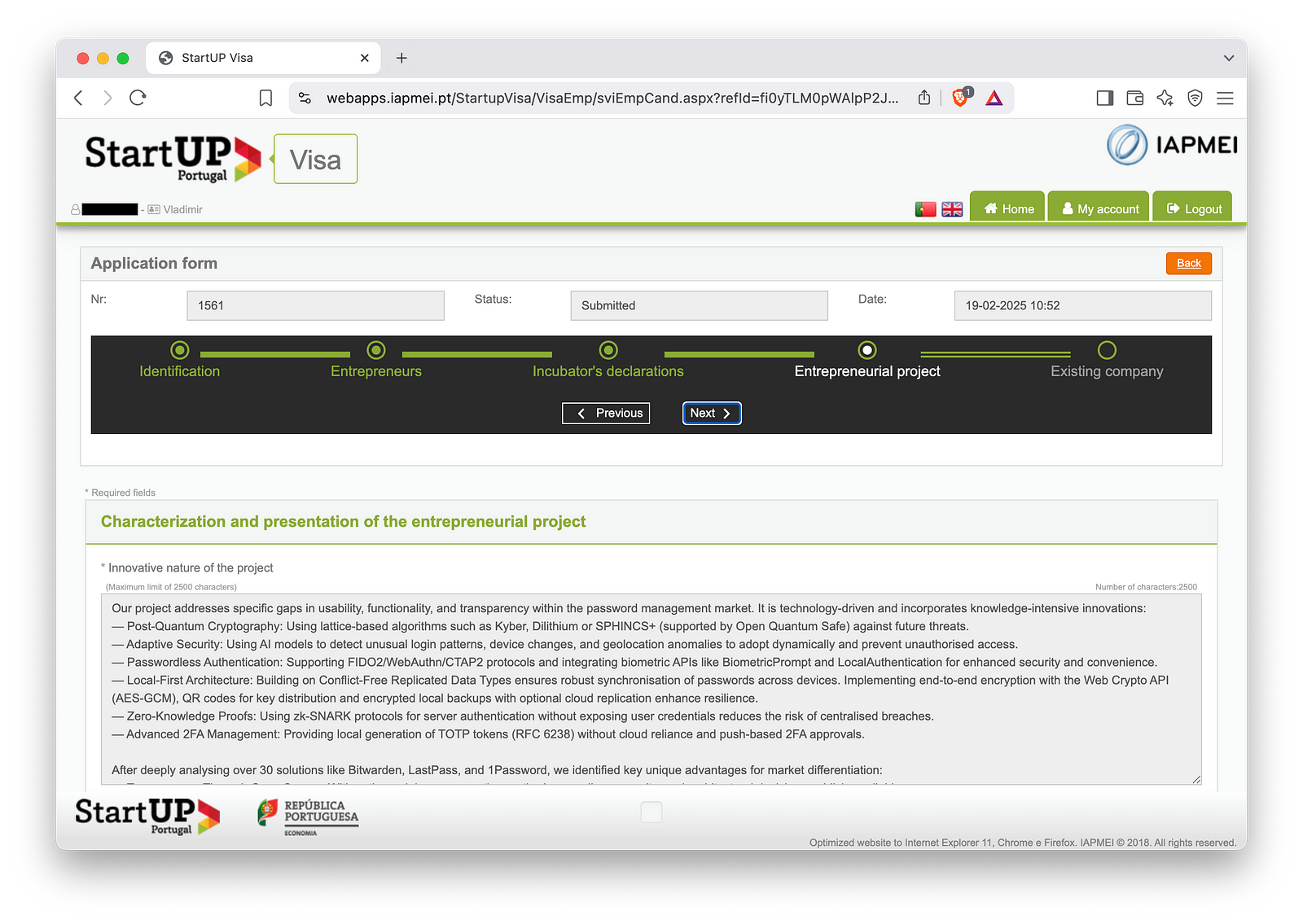
Next, we move to the Entrepreneurial Project section. Here you reveal more details on each key aspect by which the project will be assessed.
In the Innovative Nature field, you should answer the following questions:
- What technologies or knowledge drive your product?
- How does your product differ from existing market solutions in terms of features or characteristics?
It’s expected that you’ll mention several competitors. Not doing this will confuse the reviewers or demonstrate that you have a poor understanding of how to sell your product later. Our version:
Our project offers a new approach to digital security by addressing specific gaps in usability, functionality, and transparency within the password management market. It is technology-driven and incorporates knowledge-intensive innovations:
— Post-Quantum Cryptography: Leveraging lattice-based algorithms such as Kyber and Dilithium (supported by Google’s Open Quantum Safe project) to future-proof encryption against quantum threats.
— Adaptive Security: Using AI models to detect unusual login patterns, device changes, and geolocation anomalies to adjust security settings dynamically and prevent unauthorised access.
— Passwordless Authentication: Supporting FIDO2/WebAuthn/CTAP2 protocols and integrating biometric APIs like Android BiometricPrompt and iOS LocalAuthentication for enhanced security and convenience.
— Local-First Architecture: Built on Conflict-Free Replicated Data Types, the platform ensures conflict-free synchronisation of passwords across devices, even offline. End-to-end encryption is implemented using the Web Crypto API (AES-GCM) and secure QR codes for key distribution. Encrypted local backups with optional cloud replication enhance resilience.*
— Zero-Knowledge Proofs: Using zk-SNARK protocols for server authentication without exposing user credentials, reducing the risk of centralised breaches when combined with the local-first approach.
— Advanced 2FA Management: Providing local generation of TOTP tokens (RFC 6238) without cloud reliance and push-based 2FA approvals.
After deeply analysing over 30 solutions like Bitwarden, LastPass, and 1Password, we identified key unique advantages for market differentiation:
— Transparency Through Open Source: The platform is fully open-sourced, with detailed encryption methods, compliance standards, and architectural decisions made publicly available.*
— Advanced Privacy Features: Includes decoy passwords, temporary sensitive data obfuscation, and email alias integration.
— Offline and Decentralised Functionality: A local-first approach reduces reliance on centralised infrastructure, enabling password management without an internet connection — critical in regions with unreliable or insecure networks.*
— Real-Time Collaboration: Secure password sharing, role-based access delegation, and multi-user collaboration are designed for personal (families, friends) and corporate (teams, departments) use cases.*
— Advanced Recovery Options: Account recovery through Shamir’s Secret Sharing ensures secure key distribution among trusted contacts.*
The product has tangible technology prospects for internationalisation, as it is considered to align with OWASP Top Ten, GDPR’s Data Protection by Design, and WCAG 2.1 guidelines from the start, ensuring compliance across the European market. Planned certifications, including SOC 2, ISO/IEC 27001, and Brazil’s LGPD, will expand global appeal. Data residency options ensure adaptability to local regulatory requirements and build additional trust among users.
More on that topic:
At this point, I also researched competitors and the market and created a document with analysis. ChatGPT and Perplexity saved me a lot of effort. Of course, the first might answer with outdated information and is known for making up facts, but still, it’s easier to validate some pieces of information than to search for everything from scratch.
You might use the following prompts to create similar research for your case:
- List key features for a [type of product]
- List key products in a [type of products] category
- For [list of products], describe how they align with [list of features]
Add some competitors or features to the suggested list if you find it valuable.
Here, also use the market analysis from the previous part. You need to demonstrate good potential to scale in the Portuguese market first. Then — describe other markets where your product might fit, how you’re planning to sell your product there, and how you’ll need to adjust your product to them. Our version:
The European password management market demonstrated a 28% growth rate in 2019–2024. Analysts forecast global market growth from 14.3% to 27.5% yearly, reaching $8 billion by 2030. With 38% current revenue share in North America and a projected growth rate of 30% in Pacific Asia due to digital transformation and a growing number of SMEs in the region. In Portugal, the cybersecurity market is projected to grow by 7.75% annually between 2025 and 2029, reaching $239 million by 2029. Despite this growth, Portugal faces a significant shortage of cybersecurity professionals, with a 30% job vacancy rate in the sector. Password managers cover less than 25% of potential individual users, considering indirect competitors: memorisation, paper or digital notes, and browser storages. Mellon fills these gaps, providing a solution for individuals and SMEs who cannot afford dedicated security teams.
Portugal’s startup ecosystem — with over 4,700 companies and 16% annual growth — is an ideal launchpad for Mellon. The initial strategy focuses on engaging other incubator-membered startups as early adopters, mirroring Stripe’s successful approach. We start with English and Portuguese language support, compliance with the National Strategy for Cyberspace Security, and an adaptive onboarding process for different user categories to drive adoption. Tailored pricing, including family bundles and regional discounts, ensures affordability, while partnerships with local influencers and PR campaigns in media outlets like Público and Codrops enhance visibility.
Beyond Portugal, Mellon is positioned to scale across Europe in the coming years by following international standards like GDPR and OWASP Top Ten. Key differentiators from competitors include post-quantum cryptography, local-first architecture, and open-source transparency, making it highly attractive to privacy-conscious regions with high PPP, like Germany, Switzerland, the Netherlands, and the Nordic countries. Mellon’s global strategy includes:
— Partnering with open-source communities like PrivacyTools.io or Free and Open Source Developers’ European Meeting to build trust and awareness.
— Participating in programs like Road 2 Web Summit to connect with diverse audiences.
— Offering localised services, such as regional hosting providers for data residency compliance and multilingual customer support.*
More on the international business potential:
Here you might write more details on the technology or knowledge behind your project you’ve previously mentioned in The innovative nature of the product or service field. Here’s also the time to mention your technical stack and other tools, and why they’re a good fit for your product. Address scalability in the case of tech-related projects. Our version:
Let’s have a deeper dive into technologies that support the innovation of Mellon:
— AI models for adaptive security will be trained using machine learning algorithms over technical and analytics data, and co-browsing sessions voluntarily provided by our users. They will be part of the cloud API, with potential to be used locally depending on size and optimisations.
— Kyber, Dilithium, and SPHINCS+ were standardised by the US National Institute of Standards and Technology. Open Quantum Safe has already published liboqs — a C library with support for these algorithms and an exposable API for direct calls from other languages.
— Since passkeys for passwordless authentication are based on FIDO2 standards, corresponding key pairs might be generated using libraries like simplewebauthn and synchronised cross-platform with generated QR codes containing private keys and metadata.
— Local-first will be achieved by using a client-side database like PGlite with encrypted backups and a synchronisation engine like Logux, which implements the Conflict-Free Replicated Data Type mechanism. Web Crypto API is built into modern browsers and allows all data to be transferred safely between the server and various clients.
— Zero-Knowledge Succinct Non-Interactive Arguments of Knowledge is a technique to verify something without revealing sensitive data. Already implemented in libraries like SnarkJS, it allows authentication without a master password, proof that passwords or backups are correctly encrypted, and much more.
— Shamir’s Secret Sharing enables splitting a secret into multiple shares to recover account access. Nearly like horcruxes in the Harry Potter series. Probably, it will require our own implementation.
Besides the tools mentioned above, our major technical stack entities as planned:
— Bun as a modern server JavaScript engine
— Hono as a high-performance JS framework for server development
— TypeScript
— PostgreSQL
— Preact for an interactive web client
— React Native with native modules for mobile clients
— Docker
— NGINX
— GitHub Actions
— Cloudflare and other infrastructure vendors
Besides choosing performant tools, we’ll implement other decisions to enable scalability for future growth. Stateless server and local-first client architectures provide horizontal scalability, while regional hosting and CDN integration ensure low-latency performance and compliance with data residency laws.
Details:
You’re expected to enter the required data on the jobs you plan on creating in Portugal in the upcoming two operational years. The program expects that the first year is incubational — and the incubation ends with incorporating and starting your operations. That means operational years are the second and third since you’ll move to Portugal. As I applied in early 2025, I used 2026 and 2027 as the years when we plan to hire someone.
Enter only qualified job openings — from bachelor’s degree and above, even if you’re planning to hire somebody else. I.e., if you have partners in your business model (like Wolt or Uber), part-time or project employees, those don’t fit under the criteria and you shouldn’t report anything about them in this section.
It is expected that you’ll create at least 10 openings in these two years. That’s a lot, and you’ll need to show how you’re going to pay them in your business model. Our list of future hirings:
- Content Editor, Bachelor, 2026
- Full-stack Engineer, Bachelor, 2026
- Sales Manager, Bachelor, 2026
- QA Engineer, Bachelor, 2027
- Support Engineer, Bachelor, 2027
- Data Engineer, Bachelor, 2027
- Mobile Engineer, Bachelor, 2027
- Security Researcher, Master, 2027
- UX Researcher, Master, 2027
- Data Analyst, Master, 2027

That will be a tough one. Each bachelor and master will cost you. That means you have to show in your financial model how you’re going to pay them. So, it’s time to create one. I made my own version of the model, but I also have a link to another one, shared by a founder of an approved startup. Though it’s not necessary to break it down by month — startups with yearly breakdowns were also approved.
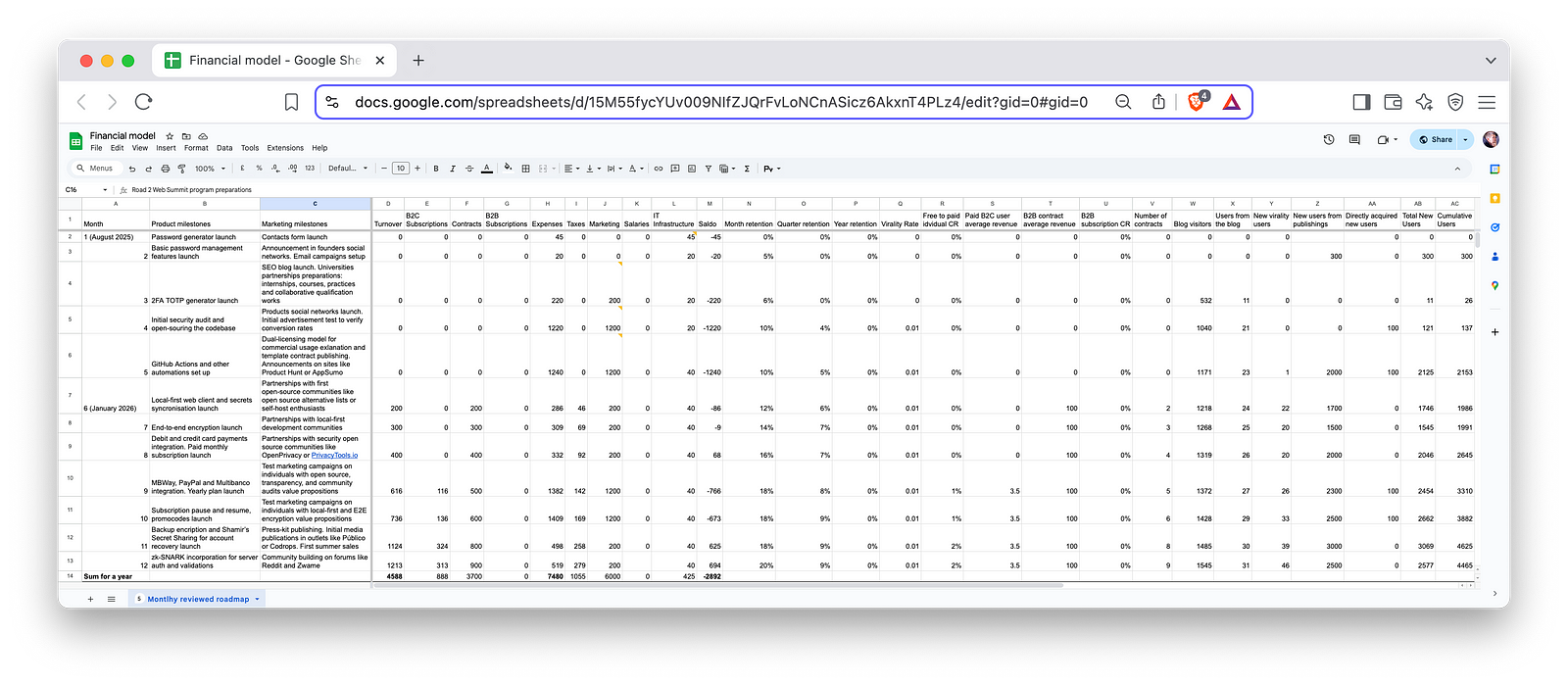
I tried to show that we’re going to bootstrap the product only with the financial means of the founders, not relying on any investments. That’s not the only option — you may also describe everything in such a way that you will need investments. But, as a result, you will have to write down where you will get them from: how you will look for investors, what sums and when you expect to raise, and what you will give in return.
It would be really great if you’re able to sign and attach a pre-agreement with some kind of fund or private angel investor. Like: “We’re ready to make $X pre-seed investments in [designation of a project] made by [founders] as soon as their application is approved and they open a legal entity in Portugal.”
Back to the justification — you need to explain why you need those hirings, their timing, and exact headcount — no more, no less. Mention when exactly you plan to hire them and their salaries. Writing my plan, I focused on recent university alumni, as the market salaries for starting positions in the Portuguese market are low. I looked for the exact numbers on Glassdoor.
Another important thing is to focus on local specialists — I heard you should not describe how you expect to attract highly qualified migrants to your startup, even if you actually do.
Our justification text:
Financial, product, and hiring strategies were aligned together to support product growth without overburdening operational costs. We minimise the money burn rate by:
— Incrementally onboarding employees in sync with revenue growth and product milestones. It also helps ensure personnel are hired and onboarded with enough attention required to choose the best available candidates and carefully integrate them into a high-speed startup context.
— Avoiding overstaffing during early stages while ensuring all critical functions are addressed.
— Offering suitable salaries that align with market standards for recent graduates in their first full-time junior or intern positions, with further income indexing, educational, and growth opportunities.
We also focus on hiring recent graduates from Portuguese universities to address the challenge of securing entry-level opportunities while fostering long-term growth and providing humble impact to the country’s economy.
As the startup grows, these employees will benefit from career development opportunities, positioning them as industry experts in emerging fields like cryptography, digital security, or cutting-edge web development.
Quarterly Hiring Schedule and Salaries
2026 Q4. 3 Bachelor graduates, €1,500/month each:
— Content Editor. Our first hired employee should be proficient in English and Portuguese, as well as in writing articles, to pick up publishing blog and social media posts. Will also help us to remove translation costs and make all the advertising creatives more native and relevant to the local market. We plan that this hire will help us double the amount of content and scale the number of new users from our blog and external publications, as it is a crucial part of growth and user acquisition strategies.
— Sales Manager. We plan to hire this position to join our company delegation at our first Web Summit. We see it as a major opportunity to sign B2B contracts for licensed usage of our product. Afterward, this specialist will drive this activity with a goal of at least 4 new contracts monthly. We’ll look for a person who is interested in negotiation practice and knows how legal entities operate in Portugal.
— Full-stack Engineer. By the end of 2026, we plan to start implementing user-facing resource-heavy features like timely prompts to take a paid plan, email alias integration to hide your real one from some services and prevent its leak, or secret sharing via generated links and other mechanics. This will require additional engineering capacity we plan to fulfill with a proficient JS developer. Afterward, this specialist will continue with other features as the user base growth will require new levels of attention implementing our product plans in code.
2027 Q2. 1 Bachelor graduate:
— QA Engineer, €1,500/month. To validate the security of sharing mechanics before their full launch, we’ll require a dedicated quality assurance engineer. Afterward, this engineer will join the work on one of the core features of our product — implementation of Post-Quantum Cryptography, as it will be an additional challenge to validate the correctness of such algorithms and pass certifications. Later, there will be plenty of work on further release automation to minimise the amount of manual checks.
2027 Q3. 2 Bachelor and 1 Master graduates:
— Security Researcher, Master’s degree, €1,800/month. Will research up-to-date articles on Post-Quantum Cryptography and verify technical implementation and usage of the algorithms, as well as study and improve general product implementation to bolster security. Will be the company’s contact for the bug bounty program. Will later participate in features like adaptive security, leak monitoring, or password rotation. Will ensure compliance with open standards.
— Support Engineer, Bachelor’s degree, €1,500/month. While ensuring high-quality experience for our users is part of each team member’s routine, we’ll require a dedicated support engineer in alignment with our strategy to make more than 50% of revenue in 2027 from B2B contracts and corporate subscriptions. As companies usually expect a faster response to their requests and raise digital security issues affecting a large number of people at once.
— Data Engineer, Bachelor’s degree, €1,500/month. Will prepare infrastructure for quantitative research based on product user base behaviour to enable further data-driven decision-making, split-testing, and data capturing for future AI model training for the adaptive security feature.
2027 Q4. 1 Bachelor and 2 Master graduates:
— Mobile Engineer, Bachelor’s degree, €1,500/month. Will enhance mobile accessibility and start to develop a cross-platform mobile application on React Native to be released in 2028. It will take some time to adapt features implemented on the website for mobile platforms and add additional ones — like usage of operating system layer vault.
— UX Researcher, Master’s degree, €1,800/month. Will describe and follow user stories and set tasks to optimise user experience and make it more intuitive for a competitive edge. That, in addition to Jobs To Be Done framework usage, is the way to acquire more users from indirect competitors: memorisation, paper or digital notes, and browser storage — and ensure that users acquired by the marketing team stay in the product and increase long-term retention.
— Data Analyst, Master’s degree, €1,800/month. Will enhance real-time and retrospective data dashboards and provide actionable insights for future decision-making, adapting both product and marketing strategies.
The turnover is expected to be over €325,000 per year. You should not enter any lower sum. Yet, you should not declare a significantly higher sum — there are high chances of being declined because “we did not find sufficient evidence that this estimate is realistic.” Empirically, this is a sum of up to €400,000. That turnover should also be supported by our financial model. In the application, I rounded up the sum from the financial model to €352,000.
Asset value is expected to be over €325,000 per year as well. And here’s the moment I still do not fully understand. Officially, it’s required for only one of the two to reach such an amount: either turnover or asset value. But, I wasn’t able to find anyone whose project was approved with only one sum stated as expected. That’s why I also indicated the value of assets above the threshold — €365,000.
Describe your financial model in text in accordance with the requirements. Calculate and justify how you plan to show the specified turnover by the end of the 5th year in this business for 5 years. The year when you arrive is considered zero — plus 5 working years.
For those businesses that already exist, justification is needed for what will be new and why it will be in demand. If you have an already implemented model in your country, then take it as a basis and describe how you will create and implement it in Portugal. It is worth attaching statistics on the existing business.
There are no obligations to meet these indicators. But in the calculations, you show that your project is capable of achieving such indicators.
To justify this, it will be important to define the target market segments, their potential, the expected market share in % to be achieved in each segment or market, as well as the price positioning in relation to competitors and substitute products.
Assets can range from anything the company possesses, such as software, intellectual property, etc. Our version:
Estimated project turnover in the 5th year of €352,000 is supported by:
— Feature abundance. By year 5, Mellon will have released and optimised basic implementations of all the core features, including post-quantum cryptography, passwordless authentication, adaptive AI-based security, real-time collaboration tools, and local-first architecture. These innovations address critical gaps in usability and transparency within the password management market, providing value for personal and corporate users. This will be the reason behind retention metrics near the top of the industry benchmark, a 5% free-to-paid user conversion rate, and a 0.2% corporate subscription conversion rate from the cumulative active user base.
— Sustainable growth. From early activities like blog and social network account launches to later penetration of other EU and South Asian countries’ markets, we’ll ensure a stable user acquisition process throughout the considered period. Constant investments of 10% to 20% of turnover in marketing will result in 39,000 active users by the end of the fifth year of operations. Thousands of new users will be attracted by webinars, blog articles, social media, and other publications — and hundreds acquired by word of mouth and direct advertisements, resulting in a consistent intake of 4,000 new monthly users from various marketing channels.
— Healthy revenue streams. The implementation of a dual licensing model, individual payment methods, and subscriptions in the first operational year, as well as loyalty rewards, trials, and family and corporate subscriptions in the second year, will help build balanced revenue streams. According to our estimations for the fifth year, we will gain nearly €148,000 in individual and family subscriptions, €126,000 in direct corporate contracts, and €78,000 in corporate subscriptions, resulting in a €352,000 annual turnover.
— Strategy optimisation. Alternating focuses on developing functionality, accelerating growth rates, and improving product monetisation allows for turnover growth: €5,000, €52,000, €228,000, €308,000, and reaching €350,000 with a break-even point and a return-on-investment ratio above 1.0 by the end of the fifth year. A significant increase in the marketing budget at this point will ensure further rapid revenue growth beyond the period under review.
— Target market segments and potential. On the one hand, we focus on individual and family users, particularly privacy-conscious users in developed markets. The estimated market size is €1.5 billion annually (Europe and South Asia combined), with Mellon targeting a modest 0.005% market share by year 5. On the other, we target small and medium-sized enterprises (SMEs) requiring secure and collaborative password management solutions. The total addressable market is €800 million in the mentioned regions, with Mellon aiming for a 0.02% share by year 5.
— Price positioning. Mellon’s pricing strategy will remain competitive. The individual subscription price is €4/month, aligning with the lower spectrum of competitors like Dashlane (€5/month) and LastPass (€3/month). The family subscription tariff is expected to be €10/month, making it cost-effective in cases of shared use by three or more users. We’ll aim to revolutionise corporate contracts and subscriptions by setting a single subscription price of €100/month, regardless of the number of employees in the company or the proportion of users among them. Here we follow Basecamp Pro Unlimited’s model, which made this SaaS company quite successful in their market and undercut enterprise-tier competitors like 1Password and Keeper Security with their €10–€12 per user/month tiers.
Leveraging strategic product launches and marketing initiatives detailed in the financial plan:
https://docs.google.com/spreadsheets/d/15M55fycYUv009NIfZJQrFvLoNCnASicz6AkxnT4PLz4/
Estimated assets value in the 5th year of €365,000 is derived from several factors:
— Revenue multiple method. This technique is widely used for SaaS companies, particularly for security or password management products. Multiplying €352,000 expected revenue by 5, which is typical for tech startups, we arrive at €1,760,000. This optimistic estimate is also backed by the expected balanced split between B2C and B2B revenue streams, an innovative product, and reaching the break-even point. On the other hand, we must account for objective risks: thin profit margins of 3.4%, high operational costs consuming 96.6% of turnover — with salaries accounting for 65% and unlikely to be reducible without layoffs — and a highly competitive market, even if it shows moderate but healthy growth.
— User-based valuation. Expecting 39,000 active users to bring €149,000 from individual subscriptions means a single average user annually brings €4. The password manager industry values users at €30 in lifetime value, which leads to an estimate of up to €968,500 in unrealised revenue from the same users — potential income to be obtained during the next 6.5 years. This is also affected by risks caused by the open-source nature of the product described below.
— Profit multiple method. An expected annual profit of €12,000 in the fifth year, multiplied by 20 (a common ratio for tech startup valuation), results in €240,000. However, considering the early stage of our product, we expect a focus on users, revenue, and growth instead of profits.
— Open-source codebase. Despite bringing advantages like transparency and community trust — which convert into selling points and growth drivers — it also limits exit options. Being available for copying and modification, this asset doesn’t generate additional value and allows migration to self-hosted replicas or cloud instances supported by other providers.
— Other assets. It’s worth mentioning content marketing assets such as a blog with 25,000 monthly visitors, an email newsletter database with up to 256,000 addresses, and 126 established B2B contracts. Considering €2–5 per monthly unique visitor, €25–50 per 1,000 addresses, and €500–2,000 per contact, we get a range of €120,000 on the low end and €390,000 on the high end.
Shrinking the possible range to a single value, and considering all the factors above, results in a humble yet seemingly realistic €365,000 estimation of potential company sale value with all of its assets by the end of the fifth year, with potential future growth aligned with active user influx, increased turnover, and profits.
Write a concrete plan for the steps you will carry out in the first twelve months after you obtain the StartUP Visa, up to the day you incorporate your company in Portugal. Think of this as your short-term objectives and what you are planning to do.
You don’t need to get ahead of the game and advertise that you will register the company faster. The company should be set up during the incubation contract and must be established by the end of this period.
Whether you expect to raise funds or not, emphasise that you have money for initial development and that you are planning to launch using your own funds.
You can describe what you plan to receive during the incubation process to show that you will use this program:
- Business management, marketing, legal advisory, IP protection, financing, and other help.
- Physical and technical resources: facilities, equipment.
- Qualified personnel, not relying solely on trainees or external consultants.
- Financial health maintenance: positive net worth and compliance with tax obligations.
- Promotional and other events.
I also mentioned how we’re going to create and improve a prototype, prepare for B2B and B2C sales, and exit incubation into acceleration:
Steps to incorporate the company during the incubation period. Pre-incubation phase:
— Set the foundation. Secure sufficient funds from our (founders’) personal resources for initial product development according to the obligations provided.— Start preparations for incorporation. Engage legal advisors in Portugal to understand incorporation requirements and draft initial documentation.
Incubation Q1:
— Prototyping and hypothesis validation. Build a prototype of the password generator to conduct small-scale user testing for hypothesis validation on password usability, security features, and local-first advantages.
— Further product development. Complete development of basic password management features and the password generator. Add a 2FA TOTP generator functionality.
— Marketing and awareness. Launch teaser campaigns on social media and through founders’ personal networks to attract early users. Initiate content development for the SEO blog and security-focused articles.
— Incubator engagement. Participate in business management, marketing, or other workshops and activities provided by the incubator. Use the incubator’s legal advisory services to finalise compliance documents.
Incubation Q2:
— Scaling product features. Conduct a security audit with external experts to fix potential breaches in code implementation. Open-source the initial codebase to build trust and transparency. Set up GitHub workflows for CI/CD automation.
— B2B sales efforts. Begin pre-contract discussions with early adopters among other companies participating in incubation or among the incubator’s alumni. Leverage incubator support to present Mellon at relevant industry events or trade shows.
— Community engagement. Launch IAMPEI’s presence on social platforms and forums. Use the incubator’s partnerships with universities to establish our own for talent acquisition and collaborative projects like internships, courses, practices, and qualification works.
Incubation Q3 and Q4:
— Final product features and open launch. Complete development of advanced features like fully local-first clients, secrets synchronisation via cloud, and full end-to-end encryption. Test and refine the product with initial B2B clients and free individual users.
— Sales preparation. Finalise initial product pricing models, selling points, landing pages, product and legal documentation, and support processes. Develop advertising creatives tailored for individual users, open source, transparency, and community audit benefits.
— Company incorporation. Register the company in Portugal during this period to meet legal and operational deadlines. Use incubator-provided resources like office space, technical equipment, and tax compliance support. Open the legal entity’s bank account to fully launch sales. Complete the incubation program and transition seamlessly into an acceleration program by showcasing a functional, revenue-generating product with established B2B contracts and a growing B2C customer base.*
Key points accompanying this incubation plan:
— Bootstrap funding. We, the founders, will self-fund the development, covering product creation, validation, and marketing expenses until the product is market-ready.
— Prototypes creation and hypothesis validation. Functioning prototypes will validate user demand and ensure a viable product-market fit before investing much into full-fledged feature development and promotion.
— Early B2B sales and agreements. Pre-contract agreements with early adopters will be signed via the incubator, allowing immediate post-incubation operations.
— B2C sales readiness. All operational, technical, and marketing resources will be prepared for a B2C launch under the newly incorporated company after the bank account is opened, the online payment provider is integrated, and accounting preparations are completed.
— Utilisation of incubation opportunities. Facilities, equipment, advisory programs, or events will be instruments in achieving milestones.
— Exit to acceleration: By the end of the incubation period, the company will be ready for an acceleration program, focusing on upscaling. We also consider picking up the acceleration program faster if we see an opportunity to start the company earlier during the incubation year.
That’s it for the project description. Now, we move to the next big chapter: describing the founding team.
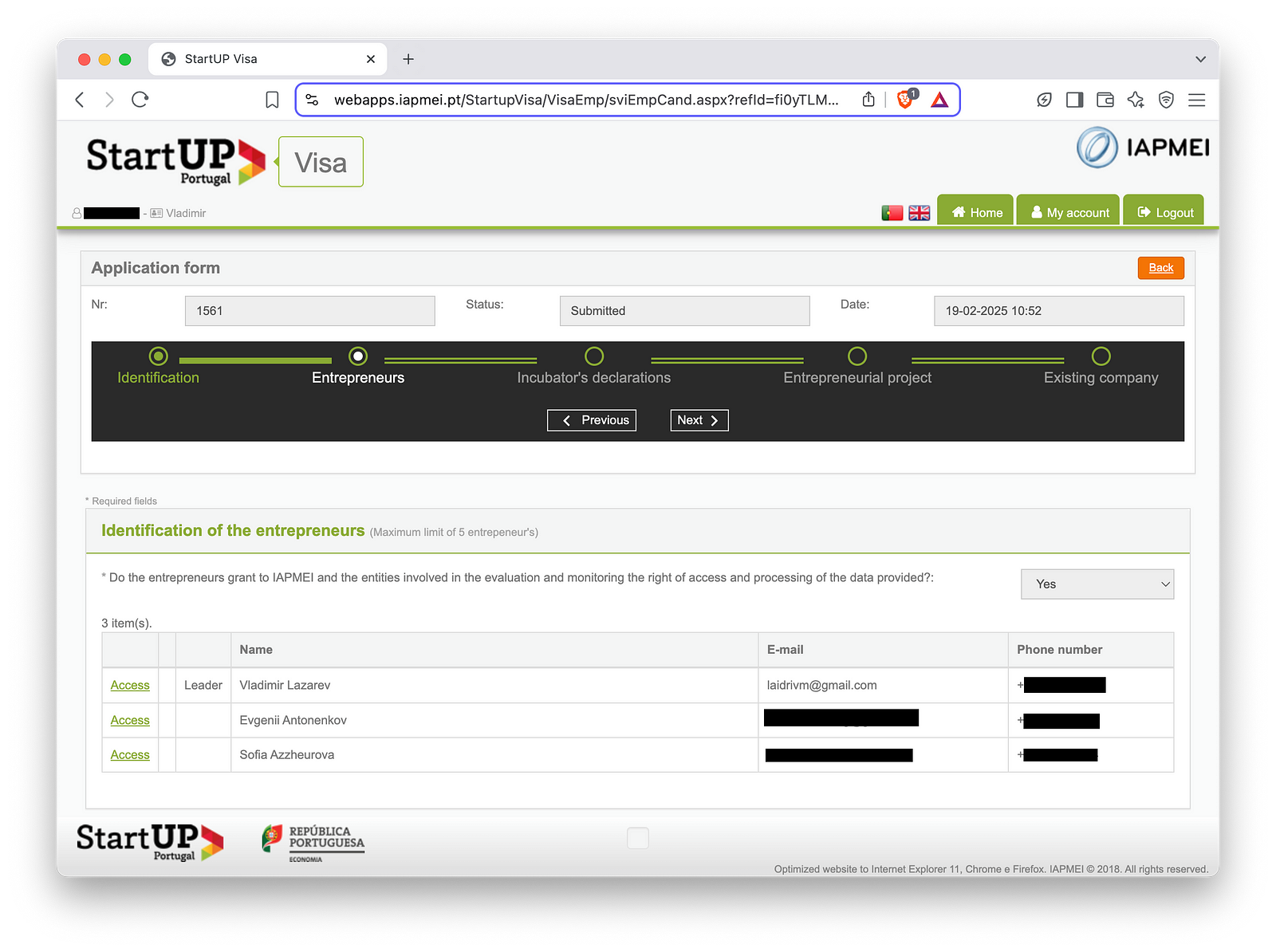
Before we get into the details, here’s what’s important. All the applicants must provide the necessary documents on time, including the additional requests. If someone decides not to send new documents and disappears during the application process, all the applicants will be rejected together.
Open the entrepreneurs page. That’s where you can edit your own information and add other founders.
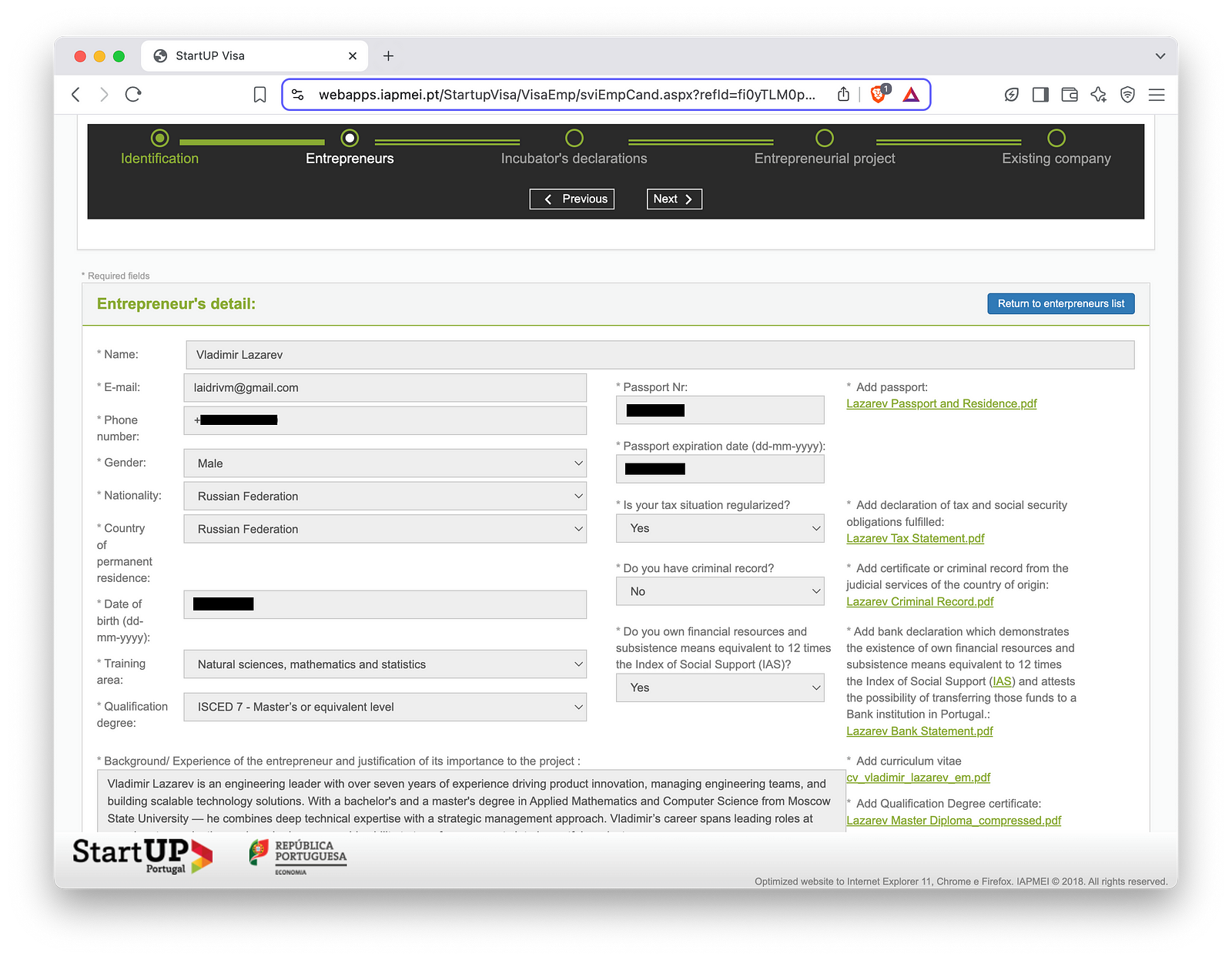
First, fill in all the basic info:
- Email — again, use personal one
- Phone number
- Gender
- Nationality (citizenship)
- Country of permanent residence — same as nationality if you don’t have a permanent residence permit issued by another country
- Training area according to your degree
- The highest qualification you have confirmation for
- Passport expiration date
- Is your tax situation regularised — yes
- Do you have a criminal record — no
- Do you have financial resources … — yes
Then, to the uploadable documents:
Basically, you just need to scan your passport. But there are situations when founders apply from a country that is not their country of origin. If they have a temporary residence permit for more than a year, they might apply with documents issued by the country they currently live in.
I have a passport from the Russian Federation, but I also have a temporary residence permit from the Republic of Serbia since 2023, the latest issued until 2027. So I attached it alongside the passport — so that I could also attach a criminal record certificate and tax statements issued here, in Serbia.
The other founder in our team has a long-term Thailand visa — but she had been living there only for a month by the time we submitted the documents. So we didn’t attach it anywhere, and she had to provide all the documents issued by Russia.
If you have a permanent permit issued by another country, you should attach it — and set the appropriate country in the Country of permanent residence field. Looking ahead, IAPMEI additionally requested from me confirmation of permanent residence in Russia — although I had already attached a foreign passport. As such confirmation, I sent a scan of my internal passport with a registration stamp and a notarised translation.
So, you need to attach a passport page with your photo. If your country issues different types of passports — attach a scan of the foreign one. If you attach a temporary permit, all the text there should be duplicated in English. Otherwise, you should also attach a notarised or court translation of this permit. Also attach a proof of permanent residence — even if it coincides with your citizenship.
Attach a certificate showing that you have no criminal record. Those who have any criminal record are refused — even if it is expunged.
There are two options for which certificate is suitable:
- Either issued by the country of citizenship
- Or issued by the country in which you have had a temporary residence permit for at least a year at the time of application
If the country issuing the certificate is subject to the Hague Convention of 1961, you will need to affix an apostille. The entire text must be in English or translated into English or Portuguese by a court translator or notary.
You need to demonstrate the required minimum amount of funds in your bank account. Do this by requesting a bank statement in English.
You need to find the actual IAS, Portugal’s social support index, and multiply it by 12. For 2025, it’s 522.50 * 12 = 6,630 euros. It’s recommended to show the amount with a reserve — at least 15% more. It’s important to note that for the visa application at the consulate, this sum might differ.
If the statement currency differs from euros, use the Google exchange rate to make sure you have the required amount. Statements, accounts, and banks in national currencies will do — you don’t necessarily need a European bank or an account in euros. Although they say that those are preferred.
In addition to the bank statement, you need a signed statement declaring that you are ready to transfer these funds to Portugal and, if necessary, use them for the development of the project. A template of such a statement:
I, [full name], born in [city] on [birthdate], a citizen of [country], passport number [passport number] issued on [issue date], declare that I have [sum from the bank statement] ([the same sum in words]) in my bank account; bank statement is attached. The money is freely available and, if my application for a startup visa is approved, I will transfer it to a bank operating in Portugal to develop my startup project [designation of the project].
[Date] [Full Name] [Signature]
Merge these two documents into a single PDF and attach it to the field “Add bank declaration which …”.
Next, you must demonstrate that you don’t have any tax obligations. Do this by obtaining a certificate showing that there is no tax debt as an individual. Have a notary or court translate it into English or Portuguese.
Next, you need a statement that you don’t have NIF and NISS — Portuguese tax and social security IDs. The template is:
I, [full name], born in [city] on [birthdate], a citizen of [country], passport number [passport number] issued on [issue date], declare on oath that I do not have any tax and/or social security number in Portugal. In case my application for a startup visa is approved, I will obtain these numbers in the shortest possible term.
[Date] [Full Name] [Signature]
If you have a NIF or NISS, that is also fine, but you need:
- another template for online checking by the Tax Authority and Social Security.
- to grant authorisation to IAPMEI.
- to attach the certificates obtained on the respective portals.
The template in case you only have a NIF:
I, [full name], born in [city] on [birthdate], a citizen of [country], passport number [passport number] issued on [issue date], declare on oath that I do not have any social security number ni Portugal. In case my application for a startup visa is approved, I will obtain this number in the shortest possible term.
I also provided all the available information regarding my tax identification number in Portugal as well as shared the right to access its information on your behalf.
[Date] [Full Name] [Signature]
To authorise IAPMEI for online checking at Tax Authority and Social Security, you need to grant them permissions on the respective portals. For that purpose, IAPMEI’s tax identification number is 501373357, and the Social Security number is 20004578827.
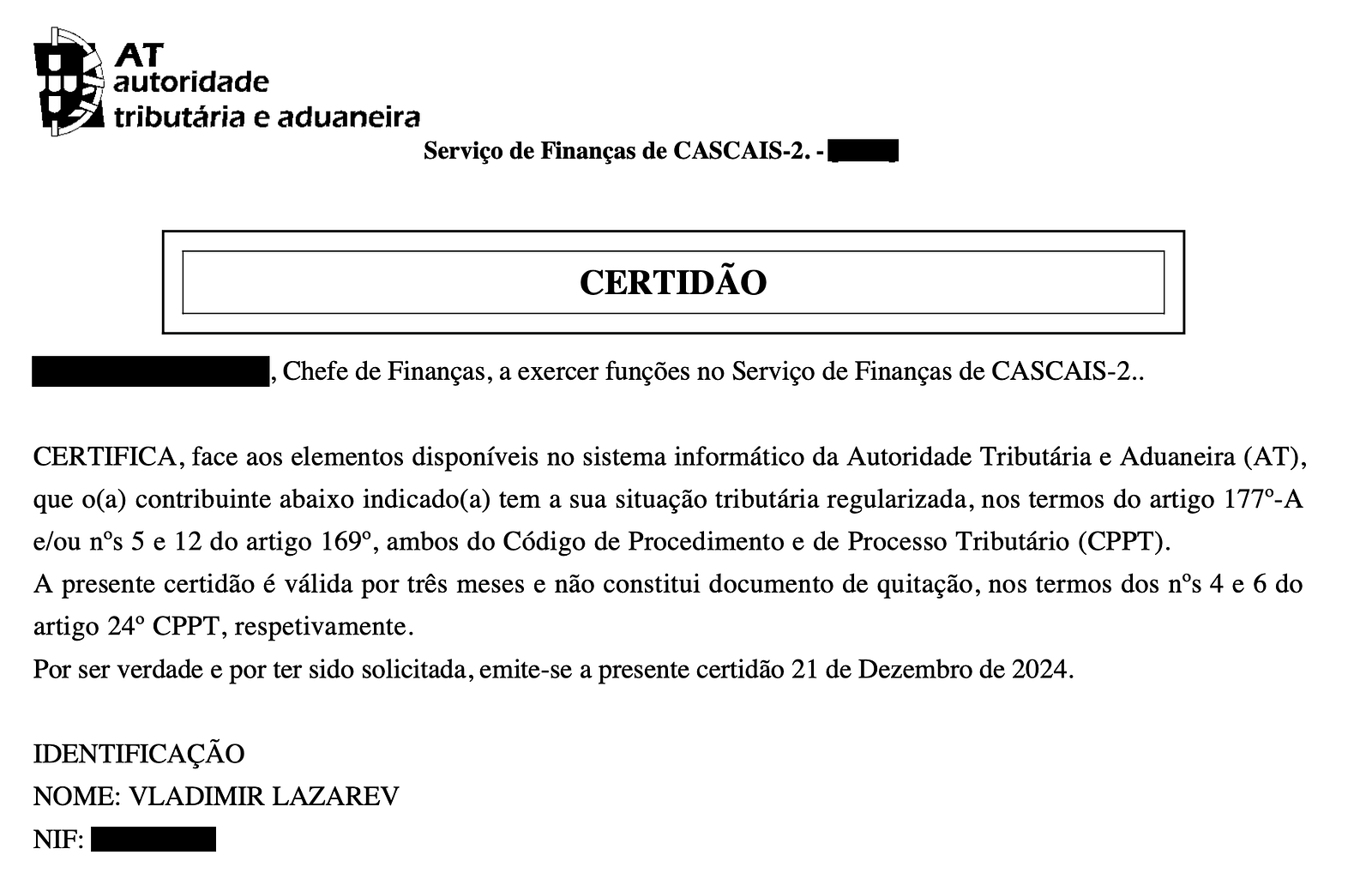
Merge all the documents into a single PDF and attach it to the field “Add declaration of tax …”.
IAPMEI expects all founders to have completed a bachelor’s education or equivalent. Applicants who have only completed a lower level of education will be declined.
If degrees are issued by a country that follows the Hague Convention of 1961, it’s better to obtain an apostille. We decided to take a risk, as only one of the founders has a degree with an apostille. Otherwise, it would have taken us a month or two more to prepare the documents. So we just attached translated versions. My diploma has some fields duplicated in English, but I still had it fully translated.
Attach a CV in English or Portuguese. I used the same one I use for job hunting:
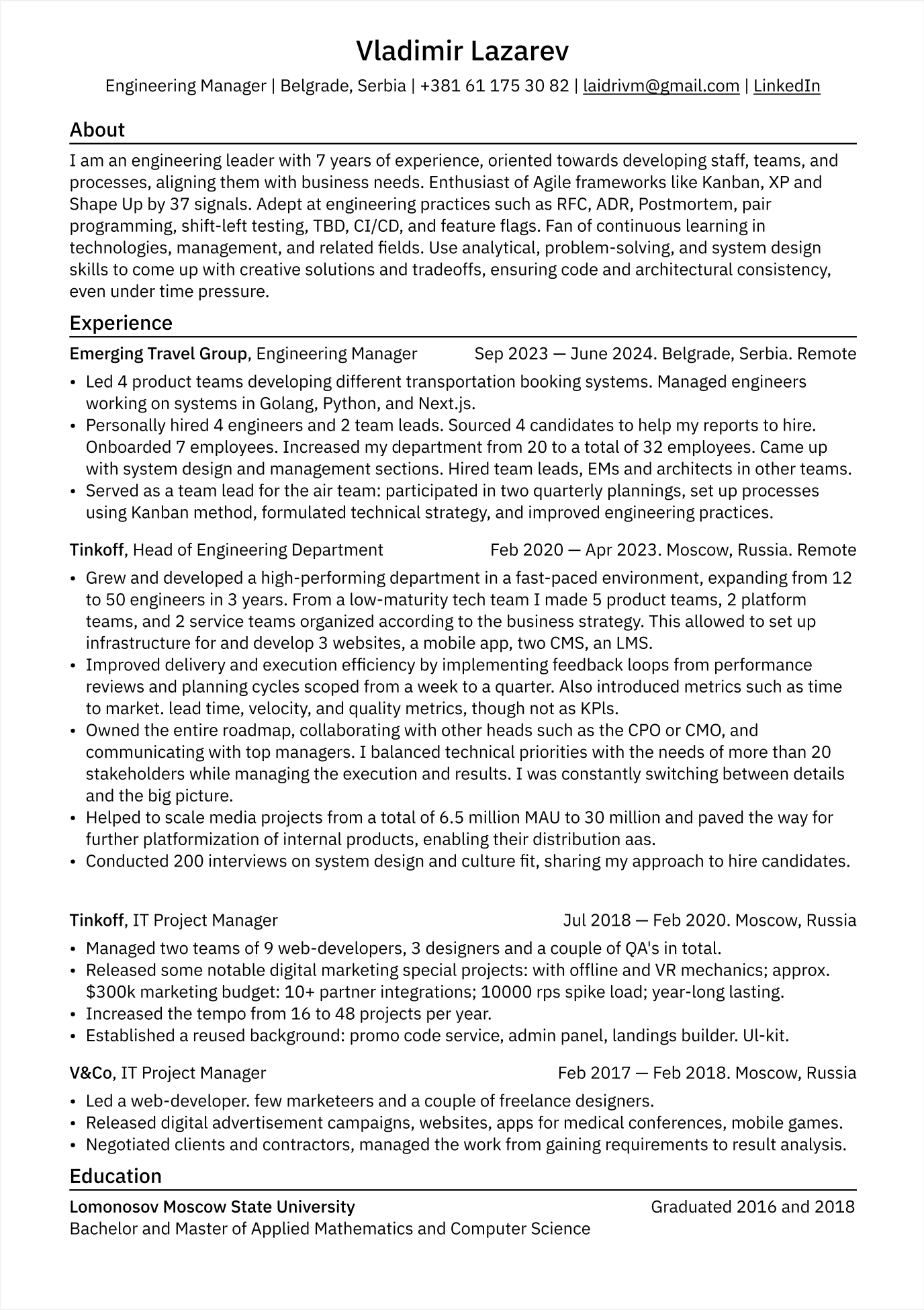
The main thing is that it should be up to date when you apply to IAPMEI. It’s fine if you’re working consistently anywhere. It just should not mention the project you’re applying with.
Here you describe the human capital behind your project — how your qualifications and background will allow you to build this product. It’s like writing a cover letter for an open position. List all the key work that needs to be done to launch and scale your project. Divide this work between the founders — whoever has the closest background and skills. Then describe how exactly the founder fits each work point.
Write it in the third person. Don’t be modest — praise yourself. I’ll give you an example about myself — but it was no worse for the other founders:
Vladimir Lazarev is an engineering leader with over seven years of experience driving product innovation, managing engineering teams, and building scalable technology solutions. With a bachelor’s and a master’s degree in Applied Mathematics and Computer Science from Moscow State University, he combines deep technical expertise with a strategic management approach. Vladimir’s career spans leading roles at prominent organisations, where he has proven his ability to transform concepts into impactful products.
Vladimir’s technical and managerial skills have been demonstrated through his leadership in product development and scaling operations. At Emerging Travel Group, an international travel tech company, he led four product teams to develop transportation booking systems, implementing cutting-edge engineering practices to ensure operational excellence. His tenure at Tinkoff, a major Russian digital bank, highlights his ability to scale teams from 12 to 50 engineers, launching high-impact digital products such as websites, mobile applications, and platform solutions that supported over 30 million monthly active users.
His technical stack proficiency includes TypeScript, Node.js, Bun, Hono, PostgreSQL, GitHub Actions, Docker, Kubernetes, and NGINX. Additionally, Vladimir’s extensive experience with system design and data synchronisation, as well as his enthusiasm, led to publishing some of Tinkoff Journal’s inventions on GitHub — aligning with Mellon’s vision as an open-source, offline-first password manager.
As Head of the Engineering Department at Tinkoff, Vladimir established mentoring, onboarding, and learning systems, which helped his department grow more than 10 recent university graduates from interns to mid-level specialists. He also mentored several interns himself and fostered continuous education among other reports, which contributed to their professional growth.
Vladimir’s entrepreneurial mindset has also been instrumental in mentoring other leaders and scaling organisations. He has directly hired, mentored, and onboarded dozens of engineers, and his experience of establishing a Serbian legal entity underscores his readiness to lead Mellon’s operations in the European market.
Vladimir’s leadership is central to the success of Mellon. His ability to deliver complex products under time and resource constraints makes him uniquely suited to guide the development of a secure and feature-rich password management solution. His interest in product management and the development of relevant skills in courses such as How to Develop a Product Your Customers Will Gladly Buy and Data-Driven Product Management Simulator will ensure that the team uses the best methodologies, maintains a clear vision, and implements a holistic product strategy.
Furthermore, his understanding of end-to-end data synchronisation and privacy-first methodologies ensures that Mellon adheres to the highest standards of user security and experience. Vladimir’s ability to balance technical innovation with business priorities will also drive Mellon’s transition into the B2B market, where his experience scaling products for SMEs will be invaluable.
Vladimir Lazarev’s exceptional technical, managerial, and product development skills position him as a key asset to the Mellon project. His experience leading global teams, managing large-scale projects, and operating within complex digital ecosystems provides the foundation needed to transform Mellon into a market leader in password management and digital security. Under Vladimir’s guidance, Mellon will address critical gaps in the market, scale its operations, and create meaningful economic and technological impact.
If you have any questions at this point, solve them before submitting anything. Use the references (listed below), community knowledge (same) or contact startup.visa@iapmei.pt.
I actively used ChatGPT and Claude in preparing materials. At the same time, I strongly advise against sending unedited results prepared by versions 4.5-o or 3.7 respectively. It is better to have typos there than to look like neuro-bullshit.
Before submitting, double-check everything related to the project and entrepreneurs for mistakes and consistency. My checklist:
- The resume and everywhere indicate specific degrees of education. And in general, everything matches everything.
- Everything that can be apostilled must be apostilled.
- Everything must be in English.
- Double-check all the documents you attached yourself before sending — that the correct and matching forms of names, dates, contacts, education, documents correspond to the people to whom they are attached, everything is signed and with translations into English or Portuguese. In external sources — LinkedIn (they find and check it), personal websites, presentations, tables — the same.
- The technologies and features are named the same everywhere. The numbers and dates in the financial model match what is indicated in the text of the explanations, justifications and other fields of the application.
I wrote out all these points while studying cases of refusals in the community. It is not exhaustive, but it is worth at least trying not to step on someone else’s rake.
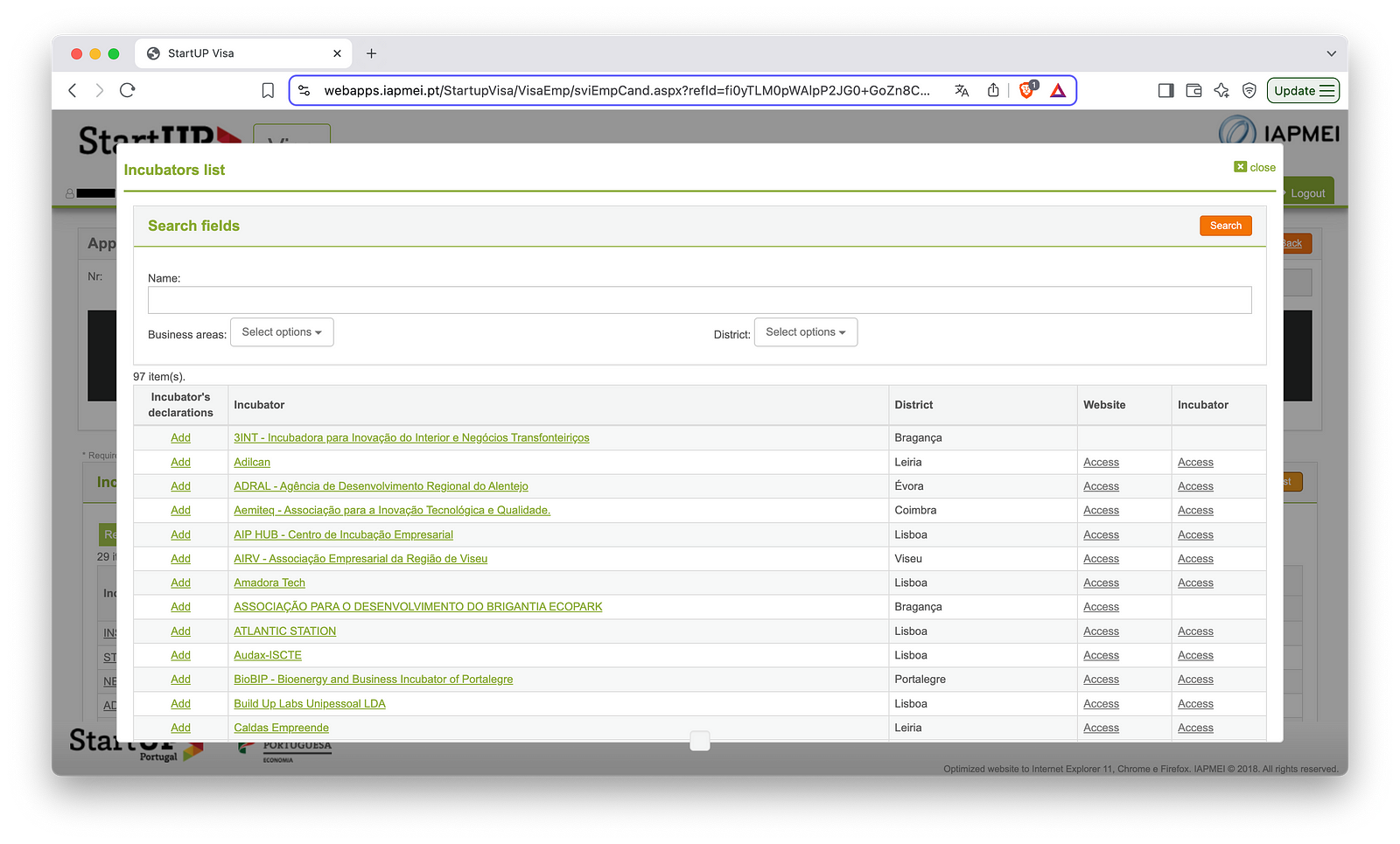
As you submit the docs, go to the Incubator’s declarations page. There find the Incubator’s list button, it will open a popup. There hit the Search button to list all the incubators. All of them are authorized to work under the startup visa program, so you don’t have to additionally check them.
The most popular incubators like Build Up Labs or Startup Factory are full to the brim. They will most likely turn you down — not because your project is bad or they are not interested, but because of the physical limitation of their capacity. You have no restrictions on how many incubators you can send your pitch to — just don’t be discouraged by rejections from the most famous ones.
As soon as you apply to any incubator, you won’t be able to edit any data from the previous steps: not project description, nor entrepreneurs’ info.
Officially, you need to get a positive response from at least one incubator — but you’d better get approvals from several ones.
I plan to move to Lisbon suburbs: somewhere like Cascais or Mafra. So I looked for the incubators comfortably accessible by car from that area. In fact, that’s not that critical. Mostly, you’ll have to appear at the incubator once per month. That’s not that frequent and increases the radius in which incubators might be located.
I also looked for incubators whose business areas align with my startup categories. You can check them by clicking the incubator’s name in the search results.
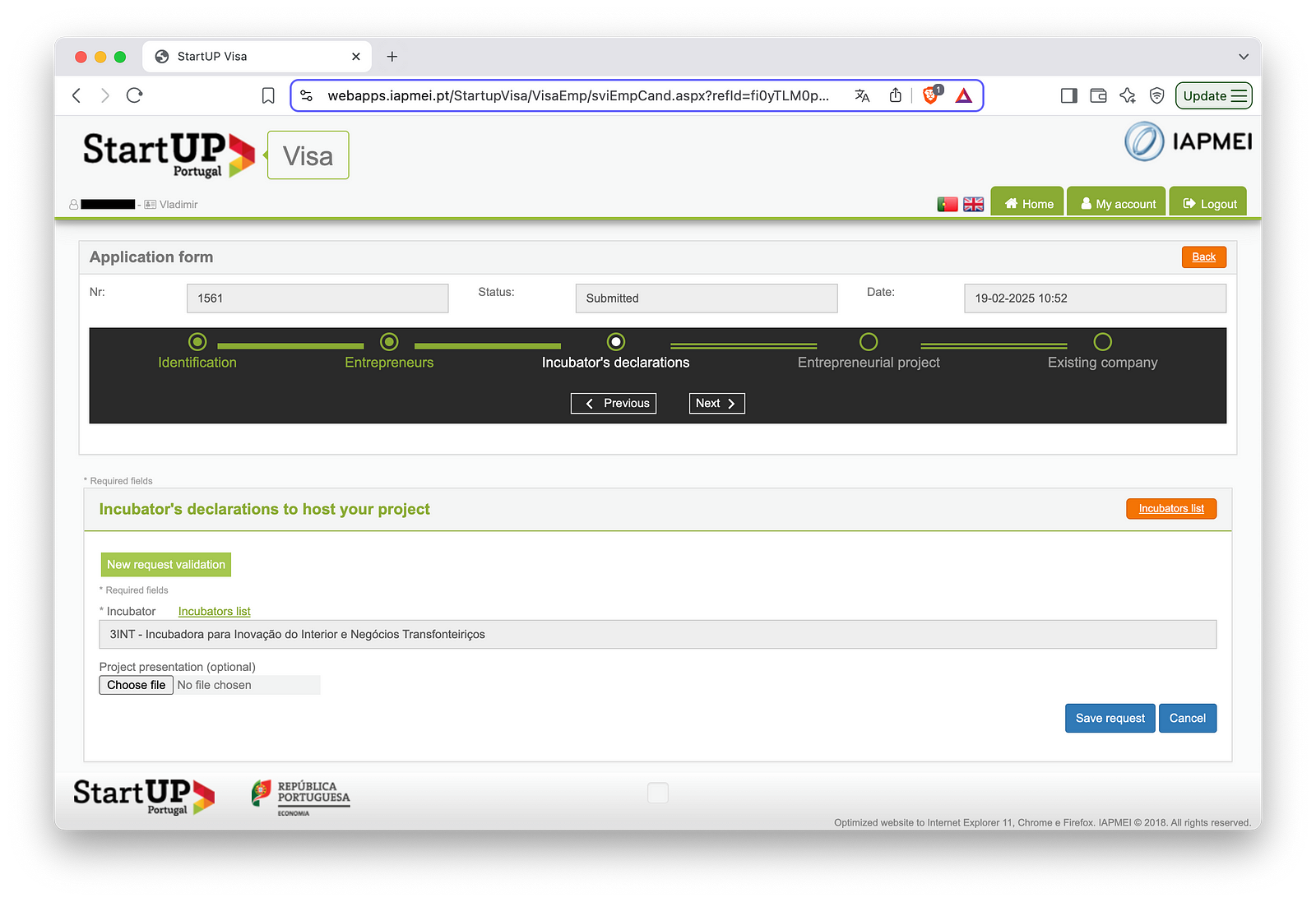
I picked 10 incubators for the first wave. And in two weeks I got only 1 approval (a week after) and 9 rejections. I bet that’s because I did not make any slides to attach to the applications. In the form it’s considered optional but it seems like it significantly influences the decision. Don’t repeat my mistake and create your slides before applying to incubators.
Still, while I was waiting for the replies, I created and published a presentation. There were 19 incubators in the second wave. There were 4 more approvals, 2 declines, and 13 applications are still pending — I doubt somebody will read them.
Once you receive the incubator decision, you can’t delete an application. But while it’s pending, you can edit it or delete — and resend it once again.
I also know folks who wrote to the incubators by email in advance. According to them, in parallel with preparing the application, they sent out a pitch to 50 incubators. In the first 3 days, about 20 responded. 4 refusals (one was very emotional and about politics), 3 said to send the application on the platform, the rest were positive — with 7 calls scheduled.
I also had a call with one of the incubators, even though they immediately approved and issued a confirmation letter:

During the call, the representative shared some info about their incubator and the program itself:
- VilaWork provides co-working, private offices and corporate tax addresses.
- It has a certified training center: with civil construction, entrepreneurship and business management programs. All of them are accessible and 99% of workshops are in English.
- They might help to apply for a program to receive up to 200k of investments for new businesses.
- They will promote your project in their social media and among their clients.
- They offer tickets or discounts to events like Web Summit, Alpha program, etc.
- In Q1 they’ll help to write an incubation and a business plan, a Y1 roadmap and submit it all to the IAPMEI.
- Every 3 months they host summary meetings to discuss progress, difficulties and plans. And after they send reports to IAPMEI.
- Every month they provide 3 hours of consultancy, everything related to the development of the project. Also brief questions could be discussed in emails or on the phone.
- Most of the Startup Visa participants throughout the country are from Russia, Brazil, Pakistan and Iran.
- They have 4 plans, from 69 to 99 euros monthly. The lowest one includes tax residence and 1 day of co-working, the highest — all the services and 24/7 access to the co-working every day.
- The contract is signed for a year. No mandatory extension. You might pay monthly, but if you pay for the whole year at once, there’s a discount of 15%.
As for the other approvals, we only received slides from InCoimbra. No more contacts or calls, but that’s okay. Just sharing for you to set the expectations.
The official application review period is 30 working days. Actually, expect the initial answer in 3–11 calendar months. But, as 30 working days expire, you have an opportunity to remind authorities about your application — to improve the approval chances and shorten the overall waiting period.
When you correctly remind about yourself, you look more interested and motivated:
- Don’t remind about your application in the first couple of months. I wrote 3 months after the application.
- Write from once a week to once a month. I know founders who followed strategies in this range and succeeded. I decided to write once a month.
- To remind about your case, write with project updates. Those might be prototypes, mockups, designs, research or whatever suits your project.
Contact addresses are startup.visa@iapmei.pt and info@iapmei.pt. Don’t forget to add other co-founders as copies or recipients.
Here’s the email I initially sent:
Hello!
I hope this message finds you well.
My name’s Vladimir. I’m one of the applicants from the Mellon project, application №1561.
As a part of the next steps in the Startup Visa application, I’m excited to share the progress me and the other co-founders have made. Over the past couple of months, our team has been focused on developing the first prototype of our product and defining the core elements of our brand identity.
We have prepared a short presentation that highlights the prototype, including key features and intended user experience — and our branding elements. Please find the slides attached. You might also want to test the prototype yourself: https://mellon.laidrivm.com/, or watch the demonstration video https://youtu.be/MI3U6LbsHZU.
We are happy to schedule a meeting or provide additional details if needed.
Thank you for your support and consideration.
Best regards,
Vladimir Lazarev
Co-founder & CTO
Mellon — Keep Your Secrets 🤫
Here are the slides I attached to this email.
I send such emails on info as well, because in minutes they reply with a confirmation that your email was registered under a reference number. I believe they have some SLAs on the maximum period to consider your appeal.
In a week we received a reply, acknowledging they received our email and will return to us with questions or a follow-up. And a week later they did — requesting some additional docs.
If you’re requested to send any additional documents, it means you’re on the right path. I have never heard about cases when applicants sent the requested papers and got rejected. Still, it’s early to relax — you need to fulfill the request first. If you ignore it, “the decision shall be delivered with the information available” — meaning you’ll be rejected.
In our case, we received the following:
In the context of your application to the Startup Visa Program, and following the approach made, it was not possible to conclude that the entrepreneur’s eligibility requirements were all complied with, as follows:
Legislative Order nº 4/2018 — article 5º, nº 1 — c) No criminal records:
According to the StartUP Visa FAQ (no 16) “The entrepreneur must provide evidence of the criminal record certificate, issued by the competent authorities, requested in the country of origin or residence, once a resident for more than a year. This must be presented properly translated and authenticated by the consulate office of the country of origin or apostilled by the Hague Convention”.
We have verified that Vladimir Lazarev submitted a criminal record certificate issued by the Republic of Serbia and Evgenii Antonenkov submitted a criminal record certificate issued by Montenegro in order to prove this requirement.
As both entrepreneurs claim the Russian Federation as their country of permanent residence, both entrepreneurs must provide an official document issued by the Russian authorities confirming their residence in this country.
Pursuant to Legislative Order nº 4/2018 of 2 February — article 6º, nº 8, we request that you send us, by this same channel (email), better reasoning and attach all the necessary documentation to prove the said requirements, within a maximum period of 3 working days.
We were confused in interpreting the request. On the one hand, the problem sounds like a lack of criminal records. Since we have claimed permanent residence in Russia, it is logical to send new certificates from there. On the other hand, we were clearly only asked for confirmation of our permanent residence in Russia. This is strange, because we attached our foreign passports. But maybe this was simply not enough.
First, we suggested attaching not only “an official document issued by the Russian authorities confirming their residence in this country”, but also new criminal record certificates issued by our country of origin. But, we asked to increase the period for accepting documents to 10 working days — it was impossible to obtain these certificates any faster.
In parallel, we prepared and submitted translated registrations from our internal passports. We did it in time.
Lastly, we submitted renewed criminal records on the fifth working day — we really were in a hurry and lucky enough to issue them that fast.
In fact, we haven’t yet received any further updates regarding our case. Now we’re preparing the second iteration of the project. We’ll use the results as project updates in our next reminder email.
Disclaimer. Here and below I only share theoretical info and the experience of other founders, as I haven’t yet gone that far myself. I hope to cover it later in more detail.
After a positive IAPMEI decision, you have 40 working days to choose an incubator on the platform. Yet you’re interested in doing it sooner. You need to contact one of the incubators that liked your project previously via their email — to ask if they are still interested, provide some additional papers and finalize the terms.
At this step you’re able to submit your request to other incubators — and sign with them. I don’t plan to use these options, as I really liked VilaWork for being nice, helpful and supportive. They also have reasonable enough terms, although they are inconveniently located.
The incubation price is considered reasonable if it falls into 60–70 euros + VAT monthly. Many incubators following the program are only interested in selling you the workspace. Yet, there are exceptions, like VilaWork, or the most successful incubators from the list. So, check the reviews, the terms, and the services included.
You can also sign a contract with a deferred start date, so you don’t have to pay for the time you’re not in Portugal yet. You need to specify the date of signing the contract and the start date of the contract. For IAPMEI this looks fine. And for you it helps to save a few payments for the time you cannot use the services anyway.
Brief reviews on the incubators from other founders:
- Build up Labs — one of the most expensive. Usually full.
- Startup Lisboa — one of the hardest to join.
- Centro de Incubação Atlântico — one table per team, but not necessarily required to use it. 145 euros monthly plus 23% taxes.
- IN Europarque — reasonable prices, provides deferred payment terms.
- Start Esposende — nice managers, quick responses. Supervised by the city mayor. Difficult to get to by public transport.
- Évoratech — provides a contract for physical incubation. Startups that do not need their equipment are given an exception — they do not have to visit the office all the time. They open a legal entity at their address — it turns out to be more profitable than in Setúbal. They promptly notify SEF (AIMA) and IAPMEI if you do not get in touch.
Of course, there are more incubators and opinions, so take your time to research and pick the most suitable for you.
After all, you’ll invite the chosen incubator to conclude the contract on the platform menu “Incubation Requests/Incubation Contracts”. The incubator, in turn, will submit the signed contract to IAPMEI. After that, you shall have access to the declaration of acceptance to StartUP Visa 🎉
But, that’s not all. You’ll have to contact your incubator once again to make an incubation plan. Incubators should submit them to IAPMEI within 20 working days after signing the contract.
That’s it, the declaration should be available on the platform. From here, you’ll be able to make an appointment at the consulate and collect the docs package II:
- Official form for visa application duly completed and signed.
- This declaration issued by IAPMEI.
- A valid passport.
- Two passport photos, up-to-date and with enough quality to identify the applicant.
- Valid travel insurance, allowing medical coverage, including medical emergencies and repatriation.
- Proof of being in a regular situation when from a different nationality than that of the country where the visa is being applied for — usually, temporary or permanent residence.
- Consent to a criminal record check by SEF — Immigration and Borders Service.
- Criminal record certificate from the country of origin or the country where the applicant is residing for over a year.
- Proof of means of subsistence as stipulated by law — bank statements proving financial stability.
For any additional requirements, check the website of the Portuguese embassy in your region.
The first year you have to work on the startup in any case — you have to provide quarterly reports to your incubator on what has been done. And they then report to the SEF (AIMA). You’ll also be able to open a legal entity, sort out taxes, prepare to extend your residence — but these are all separate stories.
It is important to remember that you can immediately start working for hire and after 2 years change your type of residency to something else. You may also qualify for reduced tax on foreign sources.
Community is a vital source of your application success. Information, like this article, can become outdated — and communities are the main way to see what’s hot right now and get feedback. I spent hours there and that helped a lot.
You can also ask for a call with community representatives. So, before preparation, I met two co-founders and found out about the application flow, info regarding financial models, limitations and other things I now share with you in this article.
I know two related Telegram chats (RU):
- Startup Visa
- StartUp Portugal — fill in the form and contact the owner.
I also applied on Startup Portugal site — but they only sent an auto-reply with all the links that were already known to me.
I can also contribute beyond this article — send your questions in an email or via Telegram. I will help as much as I can.
The stuff I looked through and applied to my case and this article:
- IAPMEI’s application platform
- IAPMEI’s official site
- Regulation Nr 344/2017, 13th November
- Legislative Order Nr 04/2018, 4th October
- IAPMEI’s Application Guide
- IAPMEI’s Application FAQ
- Social Support Indexation 2025
- Portugal’s startup ecosystem report 2024
- Official startup visa application overview
- Wiki behind one of the russian-speaking communities
- Recognition of Startup and Scale Up Status
- Immigram’s guide to startup visa (RU)
- Grown In Portugal’s guide to startup visa
- RB’s guide to work and business in Portugal (RU)
Other potentially useful resources in English:
- Grown In Portugal’s knowledge base
- 351 Portuguese Startup Association
- Guide to investment tax incentive schemes
- 200 pitch decks from VC funded startups
… and in Russian:
- Portuguese startup visa for entrepreneurs in 2021
- Move to Portugal with startup visa in 2022
- How a programmer moved to Portugal with a social project, 2022
- Portugal: Startup Visas, Ventures, Grants and Business Nuances, 2020
- Financial Model Templates
- Taxes in Portugal, tax incentives for entrepreneurs and freelancers, 2022
- How to move and grow a startup in Portugal in 2023
- Residence permit through startup visa, 2022
If you found this article helpful, please show your support by sharing it with your friends or colleagues.
If you want to talk on managing engineering teams, designing systems, or improving your tech product, send an email or message me.
Feel free to connect with me on LinkedIn.
Peace!
